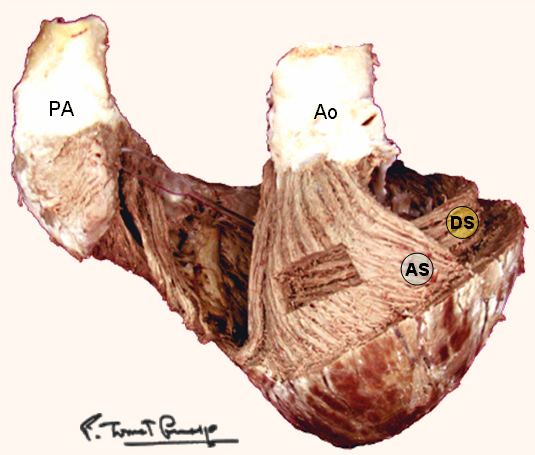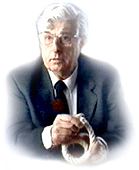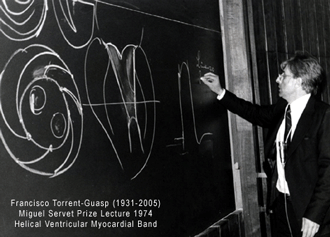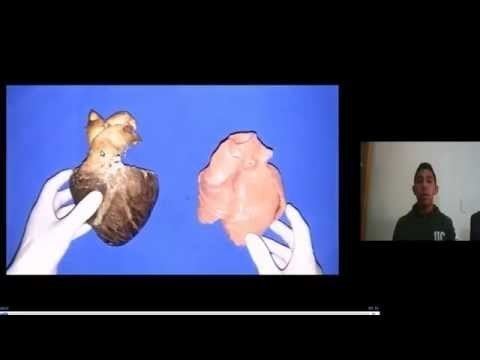Nationality Spanish Books The Cardiac Muscle | Field Cardiology | |
 | ||
Francisco ("Paco") Torrent-Guasp (Dénia, 1931 - Madrid, 2005). was a spanish cardiologist whose research focused on the anatomy and physiology of the human heart. His work led to the discovery and description of the ventricular myocardial band. His work can be found in reference books on anatomy and cardiac surgery.
Contents
- Biography
- The ventricular myocardial band
- Practical applications of the ventricular myocardial band
- Scientific articles
- References
Biography

Torrent-Guasp started his cardiac research during medical school at the University of Salamanca, Spain. He was affectionately called "Paco" by those that knew him well. During his fourth year, working with prof. Gómez Oliveros, he began to focus on his lifelong interest in cardiac anatomy and physiology. This motivated him to write his first monograph El ciclo cardiaco (The cardiac cycle)
After graduation, he started working as a family doctor in his home town Dénia, doing research during his free time, independent from the scientific community and separated from its orthodoxy, Paco understood the gap between academic and true clinical medicine better than most. Along with his research, he published monographs and presented his work in many conferences, often self-funding these activities. Starting in the 1970s and supported by the Juan March Foundation, he was able to hold dozens of invited lectures at universities worldwide. After the discovery of the ventricular myocardial band in 1972, he received the Miguel Servet (Michael Servetus) Prize in 1978 and was nominated for the Nobel Prize in medicine in the same year.
Paco Torrent-Guasp died suddenly in 2005 after giving the closing lecture in a cardiology meeting in Madrid.
The ventricular myocardial band

Several anatomists had previously focused on the structure of the heart: Andreas Vesalius, Enrico Rueda, Jean-Baptiste de Sénac, Thomas Bartholin, Jules Germain Cloquet and Robert Koch. It was well known that the heart has four chambers (two atria and two ventricles) and that its muscle fibers are intertwined on several levels. Many others have attempted to explain the mechanism of blood circulation, such as Galen, Ibn-Al Nafis, and William Harvey. Little attention was paid to the general anatomical architecture of the myocardium, the intricate layering of the muscle fibers within the myocardium and its effect on the blood circulation.

Torrent-Guasp performed hundreds of anatomical dissections of animals hearts in his Dénia laboratory. He also compared the structure of the heart in other vertebrates and annelids. From these dissections he discerned that the ventricles of the heart represent a continuous muscular band folded on itself as a helix during the embryonic development. By folding, the myocardial band crates a septum that separates two ventricular chambers of the heart close to the time of birth.

Torrent-Guasp focused further on the relationship between anatomy and physiology, i.e. between the form, structure and function of the human myocardium. It is commonly believed that that the motion of the heart (systole-diastole) is active-passive: the former is produced by the active contraction of the cardiac musculature contraction while the second by its relaxation. The ventricular myocardial band model supports the existence of an active muscular contraction that creates suction (creation of suction in diastole is extremely problematic with current theory) during ventricular diastole. Thus, it is the contraction of the ascending segment of the myocardial band that paradoxically increases the ventricular volume.
Practical applications of the ventricular myocardial band

The insights provided by the ventricular myocardial band model allows glimpses of possible advances in cardiac surgical procedures, notably those associated with the remodeling seen in hearts with systolic heart failure. This procedure aims to improve the shape of the ventricles in dilated hearts by removing part of the excess muscle tissue within the ventricular cavity (ventriculotomy). However, using Torrent-Guasp model, Drs. Suma and Burkberg replaced the ventriculotomy by placing a Dacron patch longitudinal to the muscle fibers, modeling the ventricular cavity with an abnormal spherical shape to a normal ellipsoidal shape, therefore improving the stroke volume. This procedure, called septal anterior ventricuolar exclusion (SAVE), was named "pacopexia" in honor of Torrent-Guasp.
